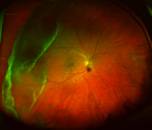Scottish engineer's eye-saving device wins European inventor's award
17 June 2008
When his five-year old son suffered a detached retina and lost his sight in one eye, design engineer Douglas Anderson from Dunfermline, Scotland, decided to invent a better device for detecting problems in the eye at an earlier stage. Fifteen years later, his patented scanning laser ophthalmoscope device has performed over 15 million eye examinations — one of which has recently helped save the sight in his son’s other eye.
Douglas Anderson and colleagues Robert Henderson and Roger Lucas were awarded European Inventor of the Year 2008 in the SME and Research category, in Ljubljana, Slovenia in May.
 |
| An image produced by the Optos device shows a retinal detachment at the periphery of the retina, detected at a sufficiently early stage for it to be repaired and the patient’s eyesight saved. |
Although five year-old Leif Anderson had had regular eye examinations, conventional examination techniques in the early 1990s only allowed the practitioner to view a limited area of the retina. Problems around the periphery often went undetected. Equipment available in specialist eye clinics could provide a greater viewing angle, but only with the use of eye drops to dilate the pupil — a slow and unpleasant procedure, especially for young children.
Douglas Anderson came up with the idea of using an ellipsoidal mirror to reflect a laser beam and provide a high-resolution digital image of over 80% of the retina in a single scan.
According to Craig Hutchison from Optos’s firm of patent attorneys Murgitroyd and Company (headquartered in Glasgow), Douglas Anderson’s invention has revolutionised eye examinations. “The ability to scan 82% of the back of the eye changed the way eye care practitioners thought about eye disease,” he says. “For the first time, they realised it was possible to detect early signs of many eye conditions by looking out to the periphery of the retina, where many eye and non-eye diseases can first be detected.”
“We got through the early stages with money from a very supportive group of local business angels,” says Douglas Anderson. “When the time came to go into large-scale production and start marketing internationally, we needed more investment. We floated on the Main Market of the London Stock Exchange in 2006 and raised £50 million. Our patent certainly made our investment proposition much stronger.”
Getting the product from concept to full production involved building prototypes and finding high-quality, reliable suppliers. Today, the Company double-sources all components from suppliers around the world, including the UK.
Optos has continued to grow and last year reported revenue for the full year ended 30 September 2007 of $86.8 million, up 28% on the previous year. Revenue for 2008 is expected to grow by 20-25%.
More rewarding personally for Douglas Anderson was the role his invention played in saving the sight in his son’s other eye. “Fifteen years after he lost his sight in one eye, the Optos device detected the early stages of a retinal detachment in Leif’s other eye,” Douglas recounts. “This time, the hospital ophthalmologists were able to treat it and save him from going blind.” The role his father’s invention has played in saving his sight might also have something to do with Leif’s choice of career: he is now working as an engineer for a Scottish firm involved in medical electronics.